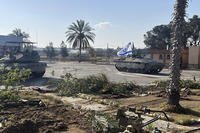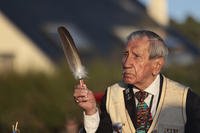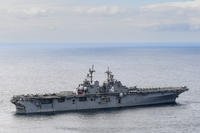Well, it was a V-22 Osprey that had the job of ferrying Osama bin Laden's body from Afghanistan to the aircraft carrier USS Carl Vinson in the Arabian sea where he was dumped overboard, according to an article in The New Yorker that stitches together a ton of details about the tech used in the raid to kill Osama bin Laden.
At dawn, bin Laden was loaded into the belly of a flip-wing V-22 Osprey, accompanied by a JSOC liaison officer and a security detail of military police. The Osprey flew south, destined for the deck of the U.S.S. Carl Vinson—a thousand-foot-long nuclear-powered aircraft carrier sailing in the Arabian Sea, off the Pakistani coast. The Americans, yet again, were about to traverse Pakistani airspace without permission. Some officials worried that the Pakistanis, stung by the humiliation of the unilateral raid in Abbottabad, might restrict the Osprey’s access. The airplane ultimately landed on the Vinson without incident.
Notice how author, Nicholas Schmidle mistakenly calls the Osprey a "flip-wing" aircraft instead of tilt-rotor. I'll forgive him given the remarkable amount of detail in this piece. heck he even points out that the White House ordered food from Costco for staffers gathered in the situation room during the raid. (seriously, who woulda thought that Costco catered for the White House?)
Another interesting part of the article details the fact that four MH-47 Chinooks were dispatched to support the initial assault team who rode in two stealthy Black Hawk helicopters. Apparently, two of the Chinooks contained a backup contingent of SEALs in case things went wrong at the raid site while the other two flew into Pakistan and landed in a riverbed were they served as a forward refueling point for the one remaining Black Hawk that left the compound.
Forty-five minutes after the Black Hawks departed, four MH-47 Chinooks launched from the same runway in Jalalabad. Two of them flew to the border, staying on the Afghan side; the other two proceeded into Pakistan. Deploying four Chinooks was a last-minute decision made after President Barack Obama said he wanted to feel assured that the Americans could “fight their way out of Pakistan.” Twenty-five additional SEALs from DEVGRU, pulled from a squadron stationed in Afghanistan, sat in the Chinooks that remained at the border; this “quick-reaction force” would be called into action only if the mission went seriously wrong. The third and fourth Chinooks were each outfitted with a pair of M134 Miniguns. They followed the Black Hawks’ initial flight path but landed at a predetermined point on a dry riverbed in a wide, unpopulated valley in northwest Pakistan. The nearest house was half a mile away. On the ground, the copters’ rotors were kept whirring while operatives monitored the surrounding hills for encroaching Pakistani helicopters or fighter jets. One of the Chinooks was carrying fuel bladders, in case the other aircraft needed to refill their tanks.
And no write up about the raid would be complete without mentioning the role played by the stealthy RQ-170 Sentinel drone:
Brigadier General Marshall Webb, an assistant commander of JSOC, took a seat at the end of a lacquered table in a small adjoining office and turned on his laptop. He opened multiple chat windows that kept him, and the White House, connected with the other command teams. The office where Webb sat had the only video feed in the White House showing real-time footage of the target, which was being shot by an unarmed RQ 170 drone flying more than fifteen thousand feet above Abbottabad. The JSOC planners, determined to keep the operation as secret as possible, had decided against using additional fighters or bombers. “It just wasn’t worth it,” the special-operations officer told me. The SEALs were on their own.
The piece goes on to provide a great account of how one of the stealth helicopters famously crashed at the scene. It also mentions the specific weapons carried by the SEALs on the raid including a silenced Sig Sauer P226 pistol, M4 carbines and Heckler and Koch MP7 submachine guns.
Check out the whole article here.









